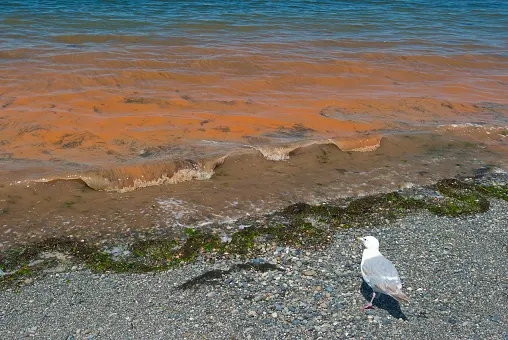
Rusty 'red tide' washes into BC coast, oyster recall issued
Editor's note: A previous version of this article featured a map from Fisheries and Oceans Canada (DFO) that incorrectly indicated widespread closures to bivalve harvesting for coastal B.C. waters. The DFO asks that people check for current closures via the DFO website to make sure the area is open for the harvest of bivalve shellfish before they go out and harvest.
Some of B.C.'s South Coast waters have been taking on a rusty hue this week, thanks to an algae invasion.
The spreading reddish waters are the big impact of a tiny species -- a type of algae called Noctiluca scintillans. During a bloom, millions of the microorganisms discolour the water, giving it its unsettling reddish tone.
The term 'red tide' can colloquially refer to a variety of so-called "harmful algal blooms" that deplete oxygen in coastal surface waters, the best-known of which occurs every summer along Florida's Gulf Coast. Several of the algae species responsible also generate toxins that can be harmful to both people and other marine life.
In the case of English Bay's current bloom, the algae responsible isn't directly harmful to humans, according to Fisheries and Oceans Canada senior research scientist Ian Perry. "I don’t think people would want to drink it," Perry told The North Shore News, "but it’s not a particular danger to people."
The same can't always be said for fish and shellfish, though.
The Canadian Food Inspection Agency issued a recall of Pacific oysters harvested earlier last week in a portion of the West Coast of B.C. associated with a Paralytic Shellfish Poisoning (PSP) algal bloom.
Toxins produced by some species of algae can build up in bivalve shellfish, including oysters, clams, scallops, and mussels. If humans eat contaminated shellfish, they run the risk of health complications, some of which can be severe. Cooking the shellfish does not remove all the biotoxins.
Fortunately for those in the English Bay area, Noctiluca scintillans isn't the type of algae that causes PSP (although the English Bay area is closed to all bivalve harvesting due to a long term sanitary contamination closure).
"Noctilica scintillans is alarming to people because of its beautiful red colour but it isn't harmful to humans or the shellfish that consume them," says Elysha Gordon, a Resource Management Biologist with Fisheries and Oceans Canada, though she adds this species of algae can clog the gills of fish species and can cause them to suffocate. "The species of algae that causes Paralytic Shellfish Poisoning (PSP or red tide) is often colourless and can occur at the same time other coloured species of algae are blooming."
Southern B.C.'s recent unusual July rainy spell may have helped spur the bloom, with nutrient-filled run-off from the land providing extra food for the algae. Wind and temperature conditions also play an important role in the explosive growth, along with salinity and ocean upwelling.
There is some evidence that the warming climate will support more frequent algal blooms. Warmer air and ocean temperatures are both more hospitable to toxic blooms, according to the U.S. Environmental Protection Agency. Toxic blooms along Florida's Gulf Coast and in the Great Lakes have become increasingly common, and problematic, in recent years. Extreme rain events also spur algae growth by increasing run-off from fertilizer-rich agricultural activities.
Sources: North Shore News | Fisheries and Oceans Canada | NOAA | Carleton College | Washington Post | CBC |





